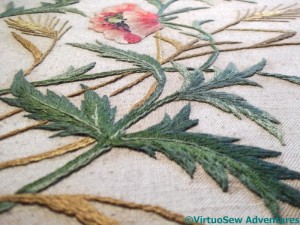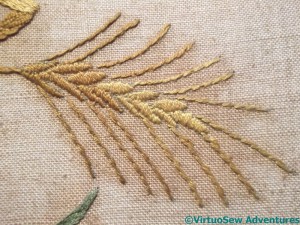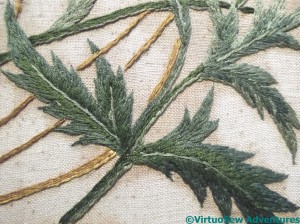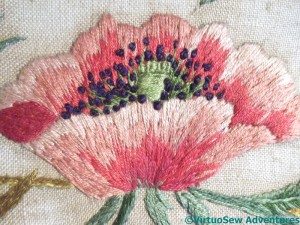Poppies and Wheat – a closer look at Grandmama’s embroidery



 When we took the tray to pieces to remove the embroidery, we had a Nasty Shock.
When we took the tray to pieces to remove the embroidery, we had a Nasty Shock.
The fabric was glued to the backing board and cut off flush with it. So much for our blithe expectation that we would be able to remount the fabric – carefully, of course! – and then get it properly framed to advantage.
In retrospect, we should maybe have guessed from the staining around the stitching that maybe some glue had been involved, but since I always mount over padding, it would never have occurred to me that Grandmama’s framer would have done anything else, still less that the legendary Miss Hunter would have presided over all that beautiful embroidery and then permitted it to be mounted onto any old piece of board using any old glue that happened to be to hand!
The embroidery is worked in long and short stitch, satin stitch, stem stitch, and French knots. I think Grandmama used two strands of stranded cotton throughout, and as it was wartime I’m impressed that she managed to gather ten different colours of thread for it.
It’s a salutary reminder to me that a riot of ornamental stitches and overdyed threads isn’ t always the very best way to achieve a striking result.
We are going to ask a textile conservator to have a look at the piece as it is, glued to its backing board, and give us some advice about the next step. Grandmama would be in pleats with laughter at the idea of any of her embroidery going to a conservator, but I hope she would be secretly pleased as well…!

Perhaps the short cutting was because it was wartime? Although I’ve no idea how that would work! I am sure that a conservator can come up with a plan – and I think your Grandmama would most certainly be delighted to know the lengths you’re going to to restore her beautiful work!
How lovely – I really like that poppy.
The simplest materials and stitches are frequently the best and most effective. Things get hard to work and less rewarding when they get too fussy, no?
Can you not still frame it with a narrow mount board?
Add oil! 🙂
It was mounted by a professional framer on straw board before we knew about acid board or inappropriate glues! I am sure the very flat presentation was because it was to be a tray, not a picture. Grandmama liked things to be useful as well a decorative. I remember loving over it as a child before it was hidden behind glass!
I particularly love the poppy. Very pretty and delicate.
Beautiful stitching – and I too love the poppy. I’m also wondering if the wartime economy, or professionalism might have compromised the mounting. If a conservator could pin that down – perhaps it should stay as is – a tribute to art continuing even during the most trying of times. It might just tell the story of this piece of history better than if you took it apart and ‘fixed’ it.
What beautiful embroidery – I particularly like the poppy. I hope the conservator can help you with your plans. I have a couple of tray cloths which my Granny embroidered – but they are simpe everyday piecces that go in the washing machine!!
Typepad are having major problems, so my blog is unavailable at the moment – fingers crossed the problem is sorted out soon!
In fact I think it’s well worth it. It’s a gorgeous piece of embroidery. Your grandmother did herself proud. I know you don’t feel the same way as I do about trays, but actually I’m sure this made a beautiful one. Having said that, maybe the conservator will be able to suggest a way of removing it from the board – since I’m sure the glue can’t be doing the fabric any good.
What a surprise! Perhaps because it was finished during wartime???
It is absolutely beautiful.
Fortunately, the materials she’s used are pretty sturdy. I’m not surprised that they used glue on it. It may well be a water-soluble, starch-based paste. I don’t know what your conservator will recommend, and I’d go by what you are told, but you might well find you can get the strawboard to come away simply by soaking the piece in warm water in the bath for a while. Then it’s just a matter of trying to lessen the acid stains: there are mild oxygen-based bleaching agents that might well improve the linen without hurting the colours on the cotton threads. So I expect all is not totally lost. It’s a lovely piece and well worth preserving.
What a beautiful piece of embroidery, definitely worth conserving as best you can.
I am sure she would be pleased at the latter but horrified at the glue!! What on earth possessed someone to do that. This is exquisite work….I see where your skill was born.
Oh, how lovely to have this and to be able to (hopefully) restore it properly. She would be very pleased, I’m sure. And I see that the Nightcap embroidery is finally finished – it is just spectacular and well worth the ‘long haul’! xCathy
This is a lovely piece. As to the glue, a conservator, who was trained at the RSN, recommended that we should glue our embroidery. I must say I was shocked as were other members of our guild. It is times like these that the value of lacing a piece comes into it’s own. The only redeeming feature may be the type of glue they used. As it was war time it is more likely to have a natural base rather than the synthetic type we use today. I do hope you can lift it.